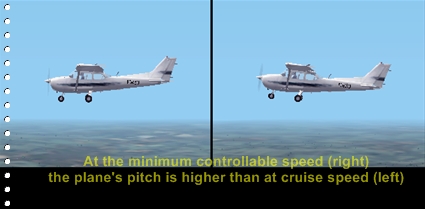 .home page .back Tutorials. GA Planes
.home page .back Tutorials. GA Planes
The concept of slow flight consists into that a pilot will have to know how to fly his plane at speeds lesser than cruise speed or at minimum controllable speed, conditions which occurs during a approach and in some takeoff and landing conditions which are the object of the tutorial 'Turbulent Air, Short-Field and Soft-Field Takeoff And Landing'
Slow flight may encompass a first idea, the one of flying a plane at a speed less than the cruise one. In some conditions, like takeoffs, climbs, descents, or landing approaches, the speed of the plane is less than the one during cruise. The pilot must master his plane at those relatively slow velocities, where flaps further are progressively set. The main line to remember is that control effectiveness decreases disproportionately to a decrease in airspeed. With each decrease in speed, the control response decreases more and more. Such conditions mostly are encountered during approach or the circuit pattern around a terrain. The question is further augmented due to that the workload of flying the plane is usually increased during those phases of a flight. Attention of the pilot should be drawn to develop his sense of using controls at such speeds. The main effect of reducing speed -even with appropriately applied flats- will show in that the plane's pitch will raise. In a identical flight configuration and maneuver, a flight at a speed lower than cruise speed will have the reference horizon relative to the upper part of the panel diminish! That in turn will need to some appropriate power and trim settings. Exercices should include maneuvers from a descent at low power and transitioning to the approach speed, level flight and medium banked level turns at approach speed. Such exercises should be performed at a safety altitude of about 5,000 feet and in a area clear of other craft. The pilot should become aware of the change in attitude of the plane and the necessity to apply needed control, speed and trim modifications. Flying at such slow speeds also implies that the pilot form the habit, beside visual reference, to frequently check flight instruments, especially the airspeed indicator
Slow flight, more technically resides into the pilot's ability to maneuver his plane at the slowest airspeed possible just above a stall conditions, which is usually 3 to 5 knots above the stalling speed. Those conditions, which are also termed 'flight at minimum controllable airspeed' mean a speed at which any further condition leading to a stall, will cause a stall! A stall is a loss of the lift due to the plane's pitch becoming too much important relative to the speed; the air flow then becomes turbulent, and stops! With the plane 'falling', loosing altitude quickly. According to what is well known by the aviators, a stall may occur at any speed -the large ones included- as the lift's loss is due to the inadequacy between the wings' angle and the speed only. Stalling is especially dangerous in the airport environment as the plane is flewn at low altitudes. Any stall will result into a definite, and potentially deadly fall
 | a comparison of the plane's pitch at cruise speed (left) and at the minimal controllable airspeed (right) |
At such a limit of speed, maneuvring the plane brings special feelings and effects like sloppy controls, ragged response to control inputs, and difficulty to maintain altitude. Slow flight in that sense also implies that the pilot both use visual and flight instruments reference, especially the airspeed indicator. As far as training to slow flight is concerned, the pilot, at a safety altitude of 5,000 feet and in a area clear of traffic, should gradually reduce throttle, maintain the altitude, set full flaps progressively, until the airspeed reaches the minimum allowable above stalling. Additional power will be required as the speed decreases. The sound of the airflow should fall off in tone level. At the minimum controllable speed, flight controls become less effective, pitch is important, as yaw also is bringing to a strong attention to coordinated flight, or sometimes cross-coordination. Trim has to be re-set frequently. Varied maneuvers like straight flight, shallow-banked turns, descent and climb should be performed with those conditions. Pilot will swiftly check that even the slighest turbulence at minimum controllable speed will need immediate required controls input to keep attitude, speed and power at the desired values. A change in flaps settings should also be performed -mostly from few to all flaps- to check how flaps applied rapidly bring the plane to the stalling speed. Both the exercises of the series -slow fligth below cruise speed and slow flight proper- should also need a situational awareness in terms that the pilot, beyond controlling the plane, should also always keep the sense of orientation
Website Manager: G. Guichard, site Lessons In Microsoft Flight Simulator / Leçons de vol pour les Flight Simulator de Microsoft, http://flightlessons.6te.net.htm. Page Editor: G. Guichard. last edited: 5/27/2013. contact us at ggwebsites@outlook.com